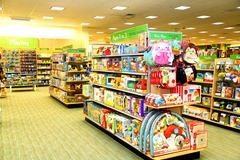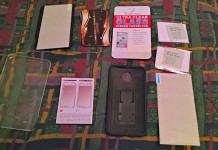 Earlier today, Paul wrote about the decline of Nook e-book sales for Barnes & Noble. The numbers are certainly interesting. It seems as though the e-reader really is a millstone around the company’s neck. But it’s not the only interesting news I’ve come across about Barnes & Noble lately.
Earlier today, Paul wrote about the decline of Nook e-book sales for Barnes & Noble. The numbers are certainly interesting. It seems as though the e-reader really is a millstone around the company’s neck. But it’s not the only interesting news I’ve come across about Barnes & Noble lately.
For a few days now, I’ve been intending to look at another article about B&N, from a toy industry magazine reprinted on Seeking Alpha before those quarterly figures came out. The author is Lutz Miller, a toy-marketing analyst and owner of Klosters Trading Corporation, so he approaches the store from a toy industry perspective rather than books and publishing. For that matter, his expertise is from outside the usual stock market advice setting. (He notes in a comment below the article that “Valuation and EPS and the like are way above my paygrade.”) It’s interesting to see this industry-outsider point of view.
It’s also a different point of view from the last Seeking Alpha piece on Barnes & Noble that I covered in September. That analyst thought that Barnes & Noble was actually in a lot better position financially than it looked, and represented a good investment opportunity. That may actually still be the case—one commenter suggested that without Nook it could be trading a lot higher than it ought to be.
But Miller thinks that Barnes & Noble is in trouble, at least as far as its sales history goes. Charts from the last six years show a steep decline in sales overall, except in the college market (which B&N spun off into its own corporate-owned subsidiary in August). Miller divides B&N’s business up into three segments—the core bookstore segment, the Nook, and toys—and notices a couple of points of interest.
First, another chart shows that B&N’s market share in the toy industry has been growing steadily over the last six years, since it first started going into boutique-style toy sections in a big way back in 2010. At about 2.5% of the total market, it’s still pretty small compared to the rest of the big players in that space, like Wal-Mart, ToysRus, Target, and Amazon, but it has been steadily gaining while most others have remained steady or even fallen (such as Wal-Mart and Kmart). In particular, Kmart’s market share looks like B&N’s in reverse—it started at about 3% but now is negligible. Miller writes:
They are engaged both in toys and collectibles and tend to be more educationally oriented than most other mass retailers. They also are pretty up to date in their assortment and have most of the best selling new products on their shelves. The products are well presented in welcoming surroundings and the staff on duty tends to be knowledgeable and helpful.
Of course, B&N isn’t the only winner there. Amazon, Ebay, and dollar stores have seen their toy market share shoot up dramatically as well, and they all have bigger shares than B&N. But Lutz isn’t really concerned with making comparisons, as he’s just discussing B&N here.
Another point Lutz brings up is that the bleed in brick-and-mortar bookstore market share over the last seven years seems to have plateaued, and in fact the trend suggests they may be in for a modest increase in the next few years. As the biggest bookstore chain in the country, B&N should be positioned to take advantage of that potential growth, but instead its store sales are tanking as it loses print-book business to Amazon as well as e-book business.
Why should that be? When Lutz compared the top-ten bestsellers between Barnes & Noble and Amazon, he found that both stores carries all titles on each others’ lists, and their prices were within 2 to 4 percent of each other. So Barnes & Noble isn’t losing out on selection, or even on price.
So what’s the answer? Lutz believes it’s customer satisfaction. He points to customer satisfaction rankings that show as Amazon’s rankings have been improving, Barnes & Noble’s have actually gotten worse from 2014 to 2015. Where the Temkin Group’s retailer ranking table shows Amazon moved up two slots to number 4 overall, Barnes & Noble fell by one to number 41.
Lutz doesn’t place the blame for this on store employees, who he says are almost always “friendly, competent and helpful.” However, his friends who work within B&N tell him that they receive “vocal, frequent, and increasing” consumer complaints about B&N’s back office service. Lutz reached out to B&N for comment himself, but received no response.
Lutz cites a research study showing that satisfied customers tend to be less vocal about their satisfaction than dissatisfied customers—a happy customer might tell five or six people while an unhappy one could complain to ten or more. He also notes that two of Barnes & Noble’s executives, veterans of Sears and Kmart, should know all about the importance of customer satisfaction, given how badly Sears did when they were there.
Lutz concludes:
Finally, I would argue two points. One is that Barnes & Noble’s troubles are self-inflicted. The second is that a remedy is very difficult because it would entail changing the company’s culture from top to bottom. Difficult? Yes. Impossible? No!
This isn’t exactly new. Amazon has been frequently and continually ranked at or near the top in customer satisfaction. Meanwhile, Barnes & Noble has had trouble providing customer service for quite some time, as this 2012 piece by Rich Adin demonstrates. Small wonder customers are flocking to Amazon in droves and away from places like Barnes & Noble. It seems to me that if publishers want to draw people away from Amazon, they should make it their business to see that Amazon’s biggest competitors clean up their act.
Meanwhile, it’s interesting to see that Barnes & Noble’s toy market share is going up, and Lutz credits this to B&N’s friendly in-person customer service staff. That rationale is very similar to what we hear from advocates of brick-and-mortar bookstores, who point out that the personal touch is missing from distant Internet firms like Amazon.
One important difference is that, even more than books, toys benefit a lot more from a personal examination rather than ordering online. After all, toys are all so different, and you can learn a lot more about them from seeing them up close—whereas books are all words on paper. The physical artifacts are largely similar; it’s just the words that are different, and you can learn about the words via the Internet.
They’re also an area where in-person customer service is more important than at-a-distance customer service. If you want to learn about a toy, you ask someone in person. If a toy breaks, you return it to the store where you bought it. You don’t have to contact someone over the Internet to ask about your e-book sale or magazine subscription, and give the faceless Internet customer service people the chance to brush you off.
It will be interesting to see what becomes of Barnes & Noble if it can get rid of its ailing e-book business. Will it end up turning into more of a toy store than a bookstore as people change the reasons they go there? Can it change its corporate culture enough to attract more customers? I will look forward to finding out.


































In the first year of NOOK, B&N zoomed from 0 market share in e-books to about 27%. Then at the end of 2010 B&N replaced their in-house New Jersey-based customer service department with a contract operation in the Philippines. B&N’s e-book share quickly flattened and then started slipping. Coincidence? I don’t think so.
With a name like Barnes & Noble, the company could move into almost any field. Heck, it could become a law firm or take up accounting.
Moving younger might make sense. Children’s books, especially picture books, are where people like to see before they buy. Print books often make more sense for kids than digital, even colorful ones with animation. It’s something physical that they can hold and control. Animation has a downside. It gives kids less opportunity to use their imagination. Also, parents can relax leaving a kid with a $3 book but not with a $50 Kindle.
As a kid, I liked to perch high up in a tree for my reading. On one occasion I was seated inside an old tire held about 20 feet up by an old rope. Suddenly, I let go of the book and grabbed the rope as high up as I could. A second later the rope around the tire snapped and I was left hanging. My unconscious must have heard the rope creaking and reacted accordingly.
That library book was only slightly damaged. If I’d be holding a $200 iPad, I would have been in serious trouble. And if I’d hesitated, I might have broken a leg.
Yes, the broken leg argument for print books. I’ll bet you never heard that before.
Your “broken leg argument” starts with you reading a book while hanging from an old rope. That calls your logic and common sense into question right there. 🙂
Just buy the kids a cheaper e-reader. I got a refurbished Sony for $20 a few months ago. They’ll drop that right away.
[…] & Noble, you have to up the customer service game. People have been complaining for years. You haven’t listened, […]